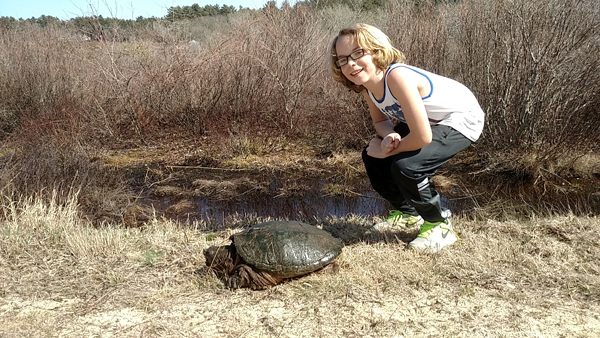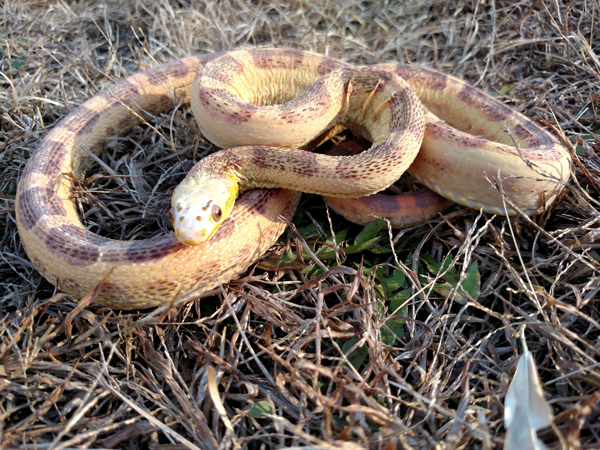There are still new and interesting facts to uncover about reptiles.
After nearly 45 years in the field of herpetology, I find it amazing that to this day there are still new and interesting facts to uncover about this amazing world of cold blooded creatures. Below I have compiled 10 interesting facts for the curious herp enthusiast. Enjoy!

leo spinner
The common snapping turtle has a remarkably sensitive shell. The author’s son Forest gives this fresh caught snapping turtle much room!
- The eyes have it: A little known fact by many herp enthusiasts is that a variety of lizard species possess what science refers to as a third eye. Monitor lizards, bearded dragons and even green iguanas as well as a whole host of other saurian and Sphenodon possess a parietal or vestigial eye. Not only does the parietal eye which lays atop the head interpret shadows of light and dark, but it connects to a pineal sac producing the sleep regulating hormone melatonin much the way the pineal gland in a human being functions.
- Naturally peculiar: With the huge increase in demand for the latest morph, we sometimes forget that all of this creative magic begins with natural anomalies. Through selective breeding we have been able to characterize specific traits often creating unimaginable beauty in specimens which are naturally bland. Albino, leucistic and piebald animals have all occurred as a natural anomaly first which triggered the curious to selectively breed them into the trend setters of today. Lately, even scale-less snakes which have been known from wild caught animals since the 1940s have taken the world by storm!
- A shell of a system: Though the shell of a turtle or tortoise certainly acts as an amazing protective barrier for the otherwise vulnerable reptile, this bony, keratin covered apparatus is actually sensitive to physical contact. Some chelonians show it more than others, but turtles and tortoises need to “feel” with their shells. Because it is a living, growing part of the body, a turtle’s sensitive shell often acts as a first alert to let the reptile know that something harmful is about to occur. Sneaking up behind a snapping turtle and gently touching the back of the carapace with an object will demonstrate very well just how sensitive the shell can actually be as the animal readjusts its orientation to confront the sensation!
- A breath from the butt! When lecturing on turtles, I am frequently asked “How does a turtle remain under water for so long, especially while brumating?” My prompt reply, “Well, simply put, a turtle can breathe through its butt!” During periods of inactivity and especially when the water is cold and a turtle's blood is not circulating so much, a turtle has the capability to respire on a cellular level through the soft tissues of the cloaca at the base of the tail and pharynx in the throat. These minute respirations are enough to keep a turtle oxygenated and alive throughout the long, cold winters.
- Snakes with claws! Although there is still much debate over the evolution of reptiles, it is commonly known that some types of snakes – notably Boas, Pythons and some Blind snakes, possess cloacal spurs or claws. Though these claws are typically used to stimulate copulation during courtship rituals, it is believed by many that the cloacal spurs are primitive vestiges of legs which would link snakes as a direct decedent of lizards.
- What?! Though it’s a well-known fact that snakes do not hear audible sounds the way we humans do, many enthusiasts do not realize that snakes do actually possess a vestigial apparatus of hearing within their heads. This rudimentary apparatus connects to the bones of a snake's jaws, allowing it to feel or “hear” vibrations with ease. It is believed by some that snakes may be able to hear actual low frequency sound with their “internal ears.”
- See what I’m saying? American alligators are amongst the most outspoken of reptiles especially during the breeding season. In the south eastern United States, American alligators can be heard for miles with their bellowing roars as the mating season commences, typically around March and April. What many herp enthusiasts don’t realize, is that for all of that bellowing there is just as much non-verbal visual communication such as body arching, mouth gaping and head slamming that goes along with the American alligator's territorial disputes and courtship demands.
- Dental plan: Reptiles such as snakes and Crocodilians frequently lose teeth and often carry these lost teeth out of their bodies through their droppings. Many pricked fingers have occurred while removing the dry snake feces from our pet’s enclosures. This is typically due to the fact that snakes and Crocodilians are constantly losing and replacing teeth, usually as a result of normal wear and tear or the growth process. In a snake, the shed teeth typically pass through the body and are expelled in the reptile’s feces. Crocodilians sometimes drop teeth directly from their mouths where the teeth often accumulate on the pond bottom. Like a shark, the snakes and crocodilians have “back-up” teeth which drop into place after a tooth has been lost.
- Now I’ll eat rocks: Alligators and crocodiles are well known for their habits of eating just about anything that they can wrap their mouths around, but many people do not realize there is an actually reason behind the crocodilians habit of swallowing inanimate objects. The swallowing of stones and sometimes heavy pieces of refuse such as metal in fact acts as ballast or helps to stabilize the aquatic crocodilians while diving in deep water. Having stones in the gastric cavity also helps to digest the hair, teeth, bones and feathers which are associated with the animals that Crocodilians regularly consume.
- A renewed vitality: It is commonly believed by many that snakes only shed their skin as a reaction to growth. Much of a snake's growth is done while not in a shed cycle but rather the actual act of shedding skin is nature’s remarkable way of revitalizing the millions of tiny microscopic facets that help to reduce friction during locomotion. Shedding of the skin also helps to repair damaged living skin and helps to remove external parasites and harmful bacteria from a snake’s outer surface, preventing skin irritations and potential infection. A snake will continue to shed its skin even during poor health.

leo spinner
The author's scale-less Everglades rat snake is a fine example of a natural anomaly
I hope that you’ve enjoyed those interesting facts regarding reptiles. Keep in mind that further research will prove that this has been just the tip of the iceberg and that there is a lifetime of interesting facts and information out there for the amateur or professional reptile enthusiast. Perhaps one day it may be your own dedication to the field of herpetology that uncovers yet unknown curious facts regarding these amazing animals!
Leo Spinner owns and operates “The Spotted Turtle Herpetological Institute” & “Skin & Scales Exotic Animal Presentations.” He has more than 45 years of captive care, research and breeding of amphibians, reptiles and invertebrates. Leo Spinner is a native of Cape Cod and resides in Massachusetts with his family.


